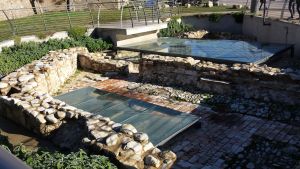Monument to the Resistance
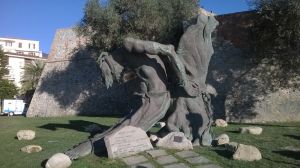
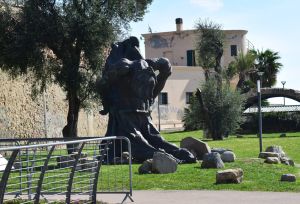 The Monument was originally placed in the centre of the square in front of it, as a symbolic replacement for the monumental fountain formed by the three M's of Mussolini from the Fascist era, which stood at that point: with the restoration work on the gardens it had to be moved slightly from the centre of the square to make room for the archaeological finds below.
The Monument was originally placed in the centre of the square in front of it, as a symbolic replacement for the monumental fountain formed by the three M's of Mussolini from the Fascist era, which stood at that point: with the restoration work on the gardens it had to be moved slightly from the centre of the square to make room for the archaeological finds below.
 The work, created by Sanremo sculptor and painter Renzo Orvieto, represents a half-naked man with his hands tied to a tree, probably an olive tree, bent forward after being shot. The sculptural group is made of bronze and measures five metres by five metres, with a depth of 3.20 metres. The placement of the monument directly on a grassy carpet, without a pedestal, is meant to symbolise the special bond that united the partisan with the land.
The work, created by Sanremo sculptor and painter Renzo Orvieto, represents a half-naked man with his hands tied to a tree, probably an olive tree, bent forward after being shot. The sculptural group is made of bronze and measures five metres by five metres, with a depth of 3.20 metres. The placement of the monument directly on a grassy carpet, without a pedestal, is meant to symbolise the special bond that united the partisan with the land.
It was unveiled on 2 June 1972 during an event held on the occasion of Republic Day, attended by over seven thousand people.
The inauguration ceremony of the monument, donated by Orvieto himself to the Municipality of Sanremo and placed in a special green space along the Giardini 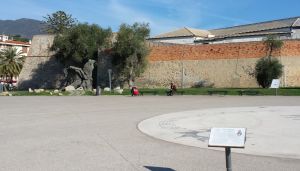 Vittorio Veneto next to the fort of Santa Tecla, was attended by delegates from partisan associations and ordinary citizens.
Vittorio Veneto next to the fort of Santa Tecla, was attended by delegates from partisan associations and ordinary citizens.
partisan associations and ordinary citizens from various regions of northern and central Italy, from Yugoslavia and France, as well as the gonfalons of the municipalities of Cuneo, Boves, Milan, Genoa, Domodossola, Sesto San Giovanni, Gorizia, Marzabotto, Vittorio Veneto, Ravenna and Stazzema, all towns decorated with the Gold Medal for Military Valour for partisan activities.
During the ceremony the mayor of Sanremo Piero Parise, the national president of the ANPI (Associazione Nazionale Partigiani d'Italia - National Association of Partisans of Italy) Arrigo Boldrini and the undersecretary for Foreign Affairs Angelo Salizzoni, who recalled how the war of Liberation had been a great popular movement and stressed the need to be vigilant to prevent the values of the Resistance from being betrayed, gave the official speeches for the inauguration of the monument.
Historical note:
During the period of the Resistance against Nazi-Fascism, Liguria, like the rest of Italy, was divided into zones in which homogeneous groups of partisan fighters operated.
Our zone was the "first Zona LIguria" and operated from September 1943 to April 1945, as is well explained in the descriptive panel in front of the statue.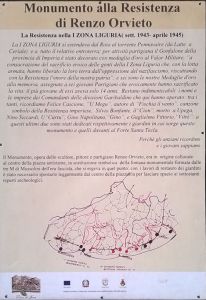 It extended from the Roja torrent (Latte di Ventimiglia) to the Pennavaire torrent (Ceriale) and all the relative hinterland; for partisan activity the Gonfalone of the province of Imperia was decorated with the Gold Medal for Military Valour,
It extended from the Roja torrent (Latte di Ventimiglia) to the Pennavaire torrent (Ceriale) and all the relative hinterland; for partisan activity the Gonfalone of the province of Imperia was decorated with the Gold Medal for Military Valour,
« consecrating the heroic sacrifice of the people of the "first zone of Liguria" who, through armed struggle, freed their land from the oppression of Nazi-Fascism, redeeming the honour of our country through the Resistance ».
Six of our Gold Medals of Remembrance have been awarded to six young Partisans who heroically sacrificed their lives: the youngest of them was only 14 years old.
Divisions of fighters from different political parties took part in the struggle and among them we remember the names and exploits of the Commanders of the Garibaldi divisions who worked here: among the many, we remember Felice Cascione, "U Megu", author of "Fischia il vento" (Fischia il vento), the symbolic song of the Imperia Resistance, Silvio Ronfante, the "Cion" who died in Upega, Nino Siccardi, U' "Cürtu", Gino Napolitano. "Gino", and Guglielmo Vittorio, "Vittò": the gardens where this monument stands and those in front of Forte Santa Tecla were dedicated to the latter two, respectively.
So that the elderly may remember and the young may know.
The inscription carved on a stone slab at its base reads:
« 25 April 1945/Heroes without uniforms/humble and proud/they make war on wars and oppressors/heroes of all time/poets and workers find death/on a single nod united/to a capestro united always in resistance ».
(sources: from the book "Sanremo Guida al patrimonio artistico e monumentale della città" (Sanremo Guide to the artistic and monumental heritage of the city); other sources; images from private archives and the Web)





